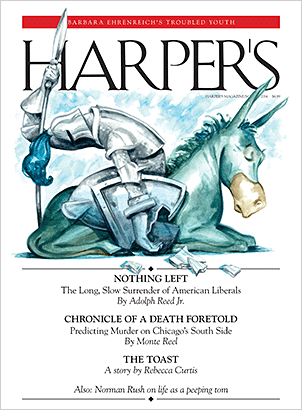Introducing the March 2014 Issue
The decline of America’s left, Barbara Ehrenreich, Norman Rush, and more
 How will future generations view the presidency of Barack Obama? In this issue of Harper’s Magazine, we present our latest commentary on the president and his legacy with a cover story by University of Pennsylvania political science professor Adolph Reed Jr. His essay is a compelling assessment of the failure of the American left. He begins with the left’s abandonment of Franklin Roosevelt’s New Deal principles and achievements, and goes on to criticize both Bill Clinton and Obama for having moved toward the center. Yet Reed’s harshest salvos are directed at the left itself, which he views as effectively dead: it stands for nothing, and is now defined only by its not being the right. A revitalized left is essential, he argues, to our electoral process — and the only way to achieve this is by resurrecting the moribund labor movement.
How will future generations view the presidency of Barack Obama? In this issue of Harper’s Magazine, we present our latest commentary on the president and his legacy with a cover story by University of Pennsylvania political science professor Adolph Reed Jr. His essay is a compelling assessment of the failure of the American left. He begins with the left’s abandonment of Franklin Roosevelt’s New Deal principles and achievements, and goes on to criticize both Bill Clinton and Obama for having moved toward the center. Yet Reed’s harshest salvos are directed at the left itself, which he views as effectively dead: it stands for nothing, and is now defined only by its not being the right. A revitalized left is essential, he argues, to our electoral process — and the only way to achieve this is by resurrecting the moribund labor movement.
As a counterpoint to the pomposity and relentless uplift of the Winter Olympics, Bill Donahue reports from Abkhazia, a disputed territory on the Black Sea a few miles from Sochi. Technically independent, Abkhazia remains a client state of Russia, and has fought almost continuously for the past twenty years in an effort to separate itself from neighboring Georgia. While money and tourists pour into Sochi, very little of that affluence is apt to rub off on war-torn Abkhazia, whose very existence as a sovereign nation is recognized by only five U.N. member countries (a sixth, Vanuatu, withdrew its recognition last year).
Justine van der Leun reports from Gugulethu, a township on the outskirts of Cape Town, where she spent more than two years getting to know the area’s residents. The township, an apartheid-era invention, was established in the early 1960s to absorb the overflow of migration to the city from other parts of the country. Now it contains almost 100,000 residents, almost all of them black. Van der Leun gives us a vivid, moving portrait of daily life in Gugulethu, as well as a window into the politics and peculiar vulnerabilities of contemporary South Africa.
Can violence be predicted? Can its perpetrators and victims be identified ahead of time? These are the questions Monte Reel takes up in his report on a new program being implemented in Chicago. Using an algorithm that ranks the likelihood that individual city public-school students will be involved in a homicide, a team of sociologists is attempting to stop violence before it happens. Highlighting the case of one teenager, Reel describes the promises and pitfalls of this futuristic (and, alas, failure-prone) program.
Also in this issue: James Marcus discusses the question of restoring the military draft; Ruth Franklin takes on two new books about E. E. Cummings, J. Hoberman reviews Twelve Years a Slave; Barbara Ehrenreich and Norman Rush describe their unconventional childhoods; and a new story by Rebecca Curtis.



